NVIDIA GeForce GTX 670 Review
It has been a while since we've had an NVIDIA card in-house for testing. Our last set of cards was a few generations back, with the GTX 275 and GTX 295 (a card I really liked). Since then we've made due with benchmarking and reviewing products solely from the AMD camp. While we've been glad to bring you the information we could, we were limited to just comparing cards within the current AMD product stack, or comparing comprable cards between generations.
Thanks to some contact made at the Rezzed Game Show in the UK, and some serious leg work by Delphium, we were able to get our hands on a current NVIDIA card - the GTX 670. I'm really glad to have an NVIDIA card back in-house, and I'm looking forward to doing a real comparison between the red and green camps.
The 600-series is really the perfect time to do an apples-to-apples (red apple vs. green apple, as it were) comparison between the two competitors. The NVIDIA 500-series brought multi-monitor gaming to NVIDIA hardware, but it required an SLI configuration. This was both problematic from a cost and implementation standpoint (some games just don't like a multi-GPU configuration).
While we could have done a solid set of single screen comparisons, there really just wasn't any way for us to do an effective multi-monitor analysis. The 600-series now gives us NVIDIA Surround on a single card, and opens things up for a proper WSGF shoot-out.
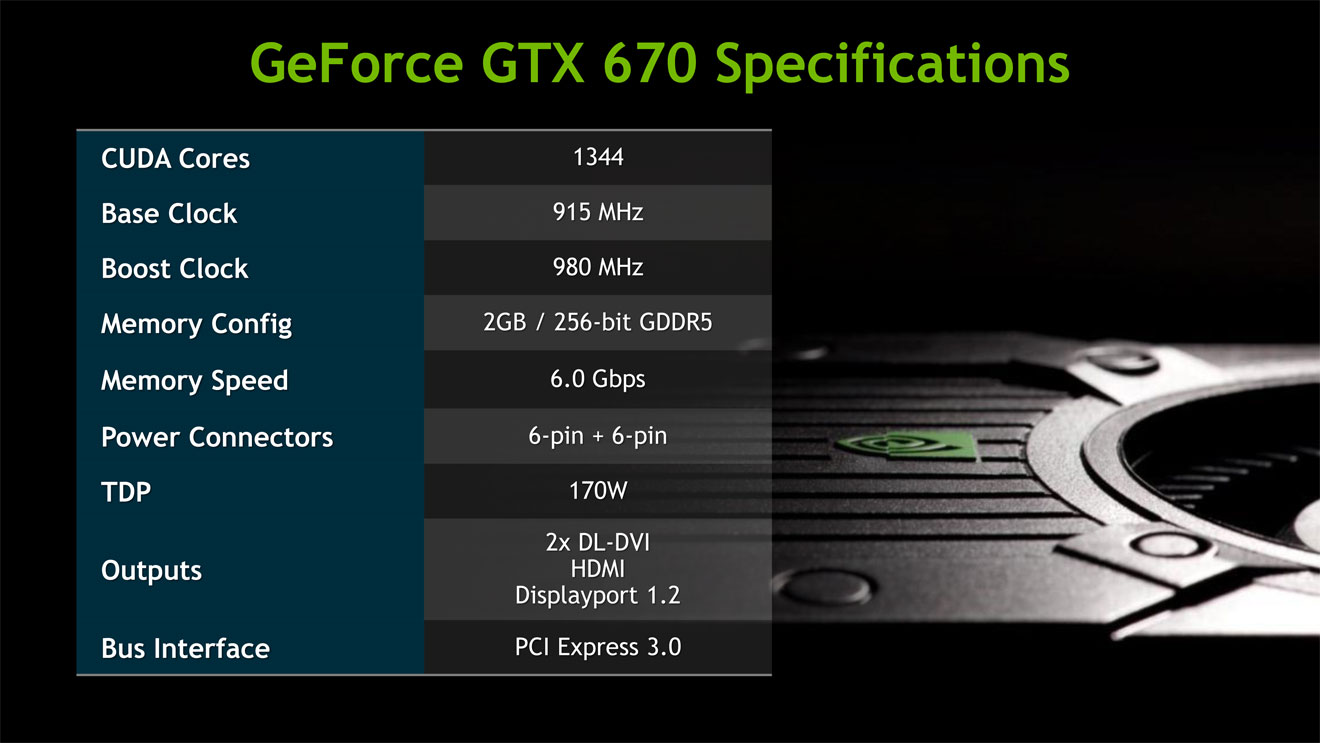
Architecture
NVIDIA introduced us to the Fermi architecture with the 400-series. It delivered strong performance at the expense of power draw, noise and heat. They refined Fermi with the 500-series into a more efficient and "better behaved" product, while producing better performance over the first iteration. Overall the architecture was built around fewer CUDA cores (shader processors), running at a high frequency.
NVIDIA has taken a solid shift with the Kepler architecture in the 600-series. They dramatically increase the number of CUDA cores, while cutting the shader clock rate. In the 500-series the shader ran at double the clock rate of the core, with the memory then having its own clock. With the Kepler architecture, the core clock and shader clock are now the same, with the memory running at its own speed. This brings NVIDIA in line with AMD on their general architecture outlook - massive number of shaders working parallel, with a unified core and shader clock.

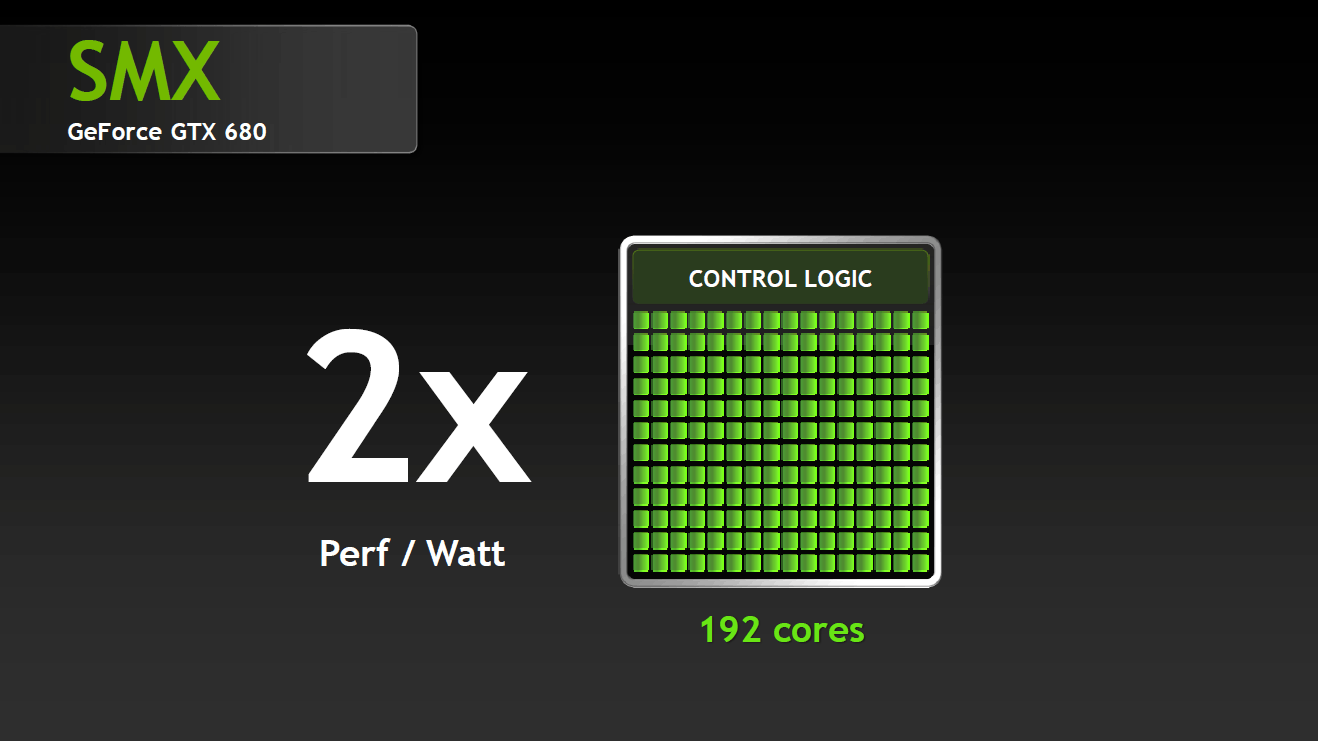
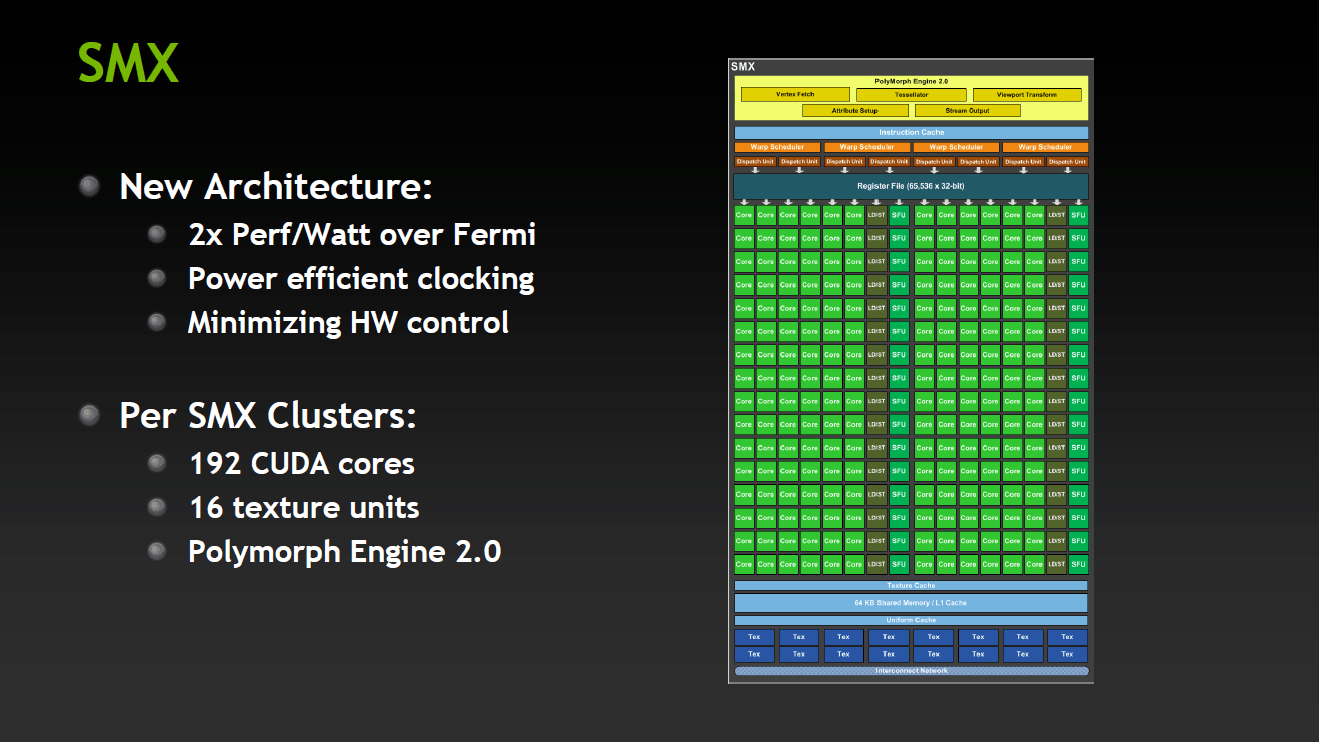
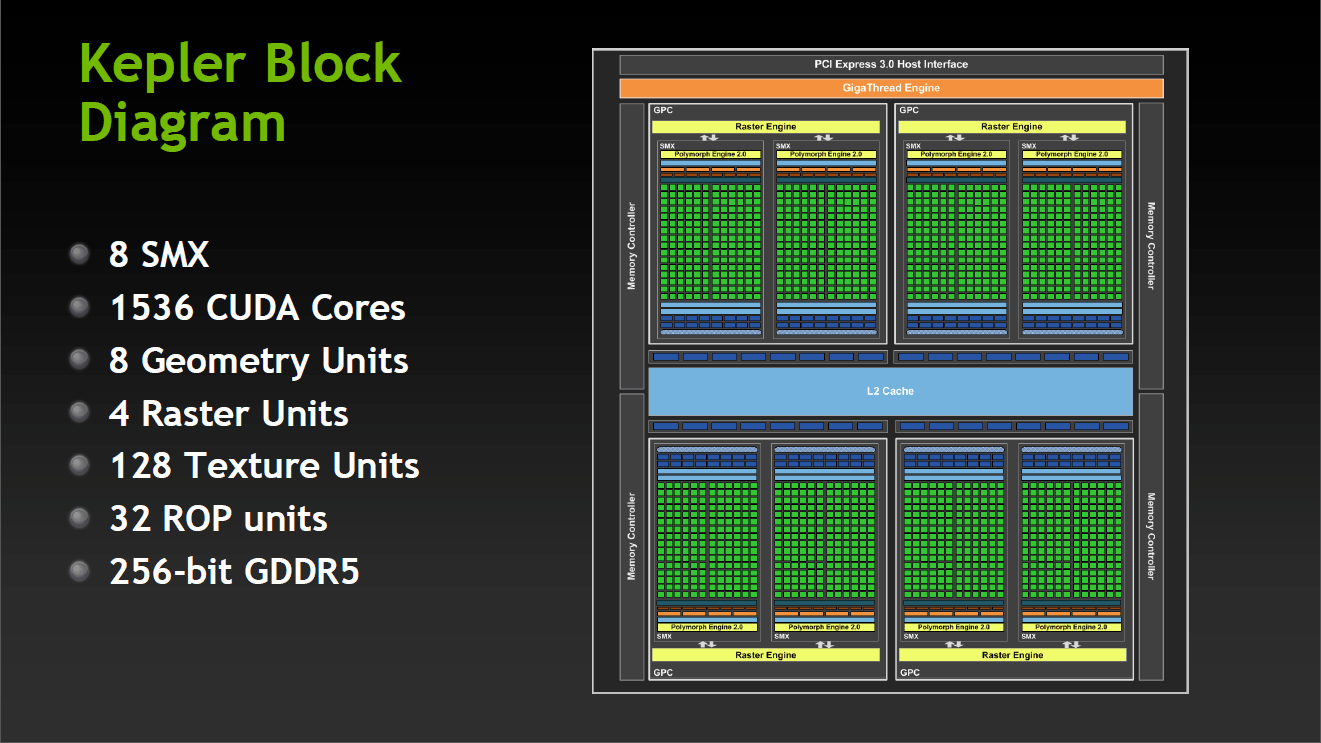
Reference Specifications
The GTX 670 is targeted at the high end of the market, and is NVIDIA's counterpoint to the AMD Radeon HD 7950. In our testing we will be comparing the NVIDIA GTX 670 to both the Radeon HD 7970 and the Radeon HD 7950.
The specific card we are testing is not a reference card, but a retail SKU from MSI. It is an overclocked version, with the model number of N670GTX-PM2D2GD5/OC. It carries a base clock of 965HMz and an average boost clock of 1045MHz. Being an OC'd card, it will perform a bit better than the base reference design. However, looking at Newegg the card only carries a $10 premium and was actually on sale for the MSRP of $399. Considering you can get OC performance for reference pricing, I believe it's fair to pit this model against the AMD reference designs.
| Card | GPUs | Transistors | Mem/Bus | Shaders | Clock (MHz) | TDP (Watts)* | Power | MSRP | ||||
| Core | Boost | Mem | Idle | Max | ||||||||
| AMD Radeon HD 7970 | 1 | 4.3B | 3GB / 384-bit | 2,048 | 925 | --- | 1375 | <3 | 250* | 8+6-pin | $429 | |
| NVIDIA GeForce GTX 670 | 1 | 3.54B | 2GB / 256-bit | 1,344 | 915 | 980/1084 | 6000 | ??? | 170 | 6+6-pin | $399 | |
| AMD Radeon HD 7950 | 1 | 4.3B | 3GB / 384-bit | 1,792 | 800 | --- | 1250 | <3 | 200* | 6+6-pin | $349 | |
| *The Radeon values represent the maximum wattage allowed through the AMD PowerTune. Idle for the Radeon cards is based on a "long idle" scenario. | ||||||||||||
NVIDIA GeForce GTX 670 Review - Adaptive VSync, GPU Boost & More
GPU Boost & Adaptive VSync
The great thing about competition is that it brings out the best in good competitors. AMD has offered product improvements in power consumption with features such as Long Idle and ZeroCore. With the release of the 600-series, NVIDIA has added two new performance features - GPU Boost & Adaptive VSync.
With the Radeon HD 7900 series, AMD implemented its Overdrive feature. This feature allows the user to increase the max power draw to the card, giving a boost for overclocked performance (if the application or game needs the boost). If the game or app didn't need the increased performance, it wouldn't pull the extra power draw; saving energy and heat. NVIDIA now offers a similar feature with GPU Boost.
Rather than offering a driver setting for dynamic overclocking based on power draw, the NVIDIA hardware itself comes with the built-in feature for dynamic overclocking. The NVIDIA software (driver) and hardware work in conjunction to measure 13 different data points regarding performance. It dynamically determines when an increase in performance is needed, and boosts the card's clock frequencies as much as needed (or possible).
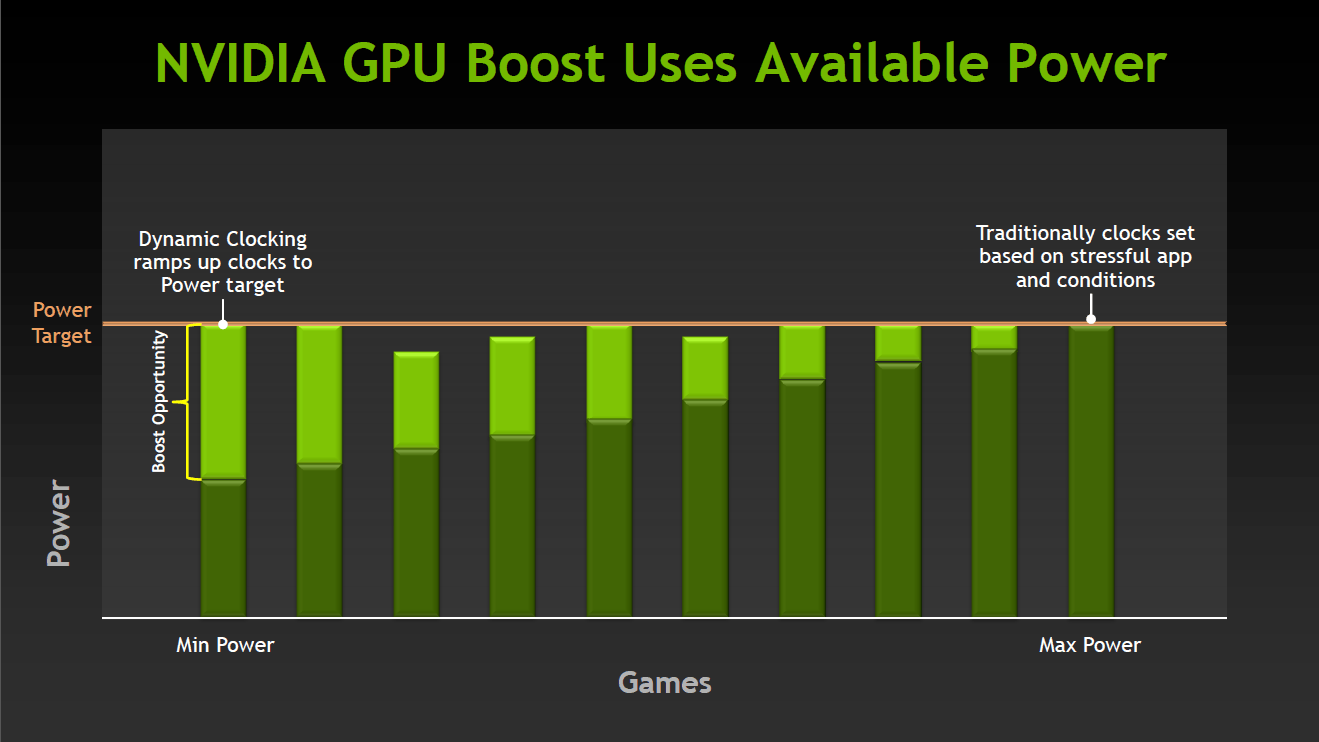
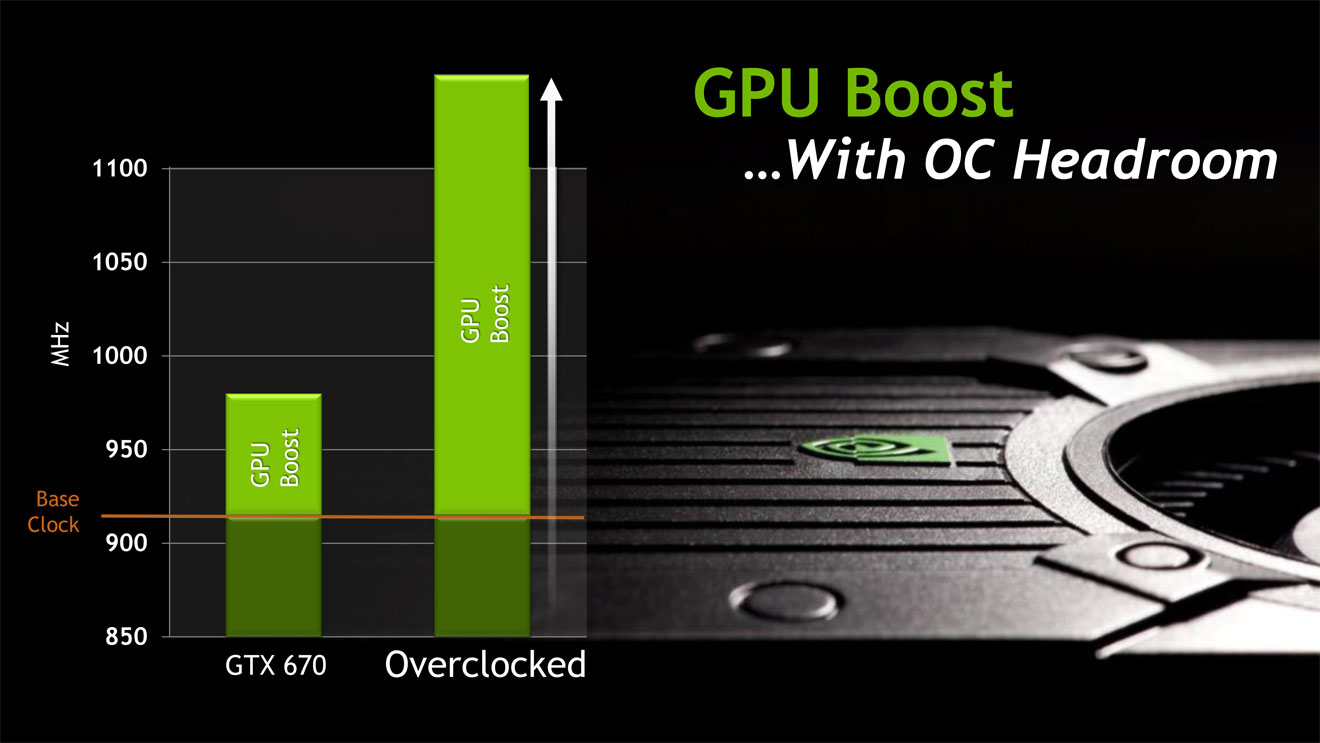
In reality, the "stock" clock of an NVIDIA GTX 670 is now its base clock. The cards are then specced with a specific average and max boost. There is now no real way to measure an NVIDIA card at "stock" clocks. We can simply note the base clock, and the boost range.
Along with this performance boosting feature, NVIDIA is also offering an intriguing and unique "limiter" - Adaptive VSync. Traditional VSync is used to sync the framerate of a game with the output of a monitor. This is traditionally useful to reduce "tearing" that appears when game performance outstrips the monitor refresh rate. In a sense, the game gets ahead of the monitor.
With VSync disabled, you get an experience that can be described as bi-polar ("hurry up and wait", or possibly "creeping then running"). The user ends up being rubber-banded between these extremes of performance, and the gameplay experience is very poor.
The problem with VSync is that it forces the game to run at a multiple of the monitors refresh rate (usually a multiple of .5x). So, what happens if a game generally runs at 40-50fps, with a few occasional spikes well above the 60Hz refresh? VSync will limit the high-end of the extreme, and cap performance at 60fps. This provides a more consistent and enjoyable experience, even if the average fps is actually lower. The problem is that since the 40-50fps sections don't meet the 60fps threshold, they are artificially dropped to 30fps.
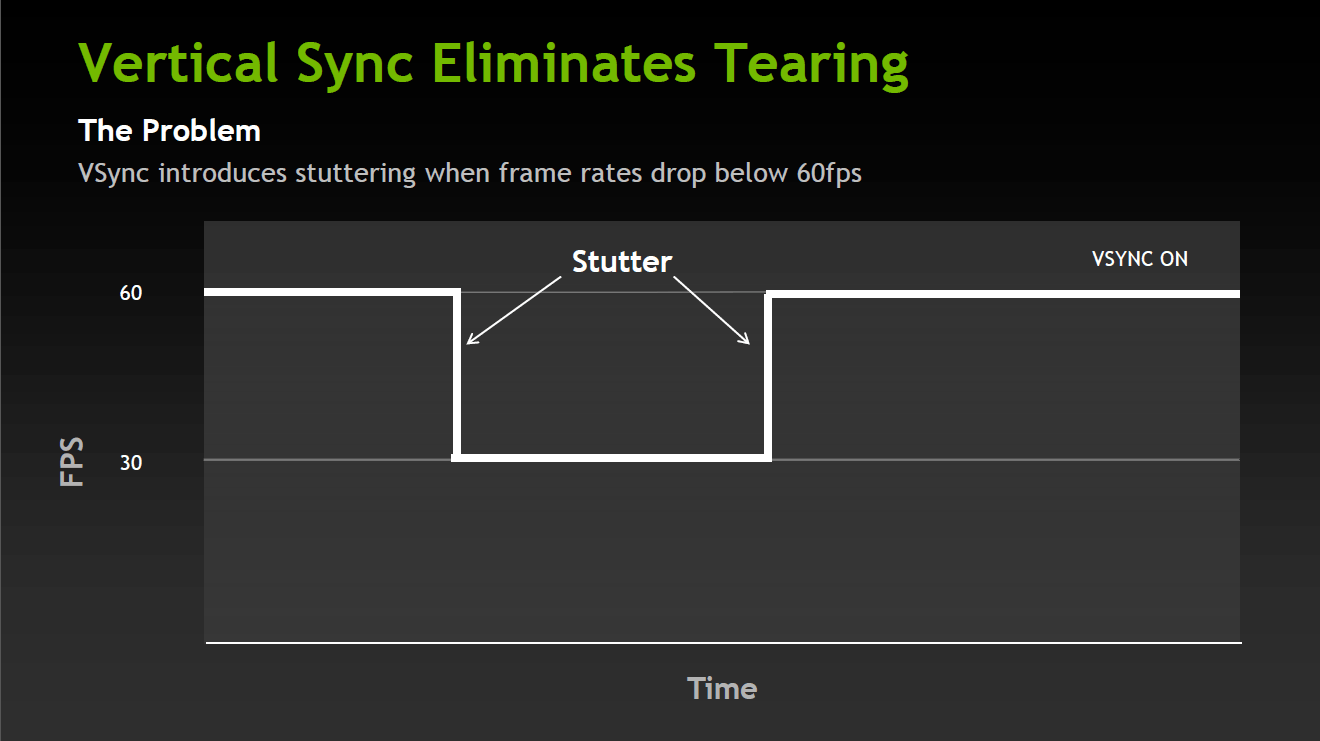
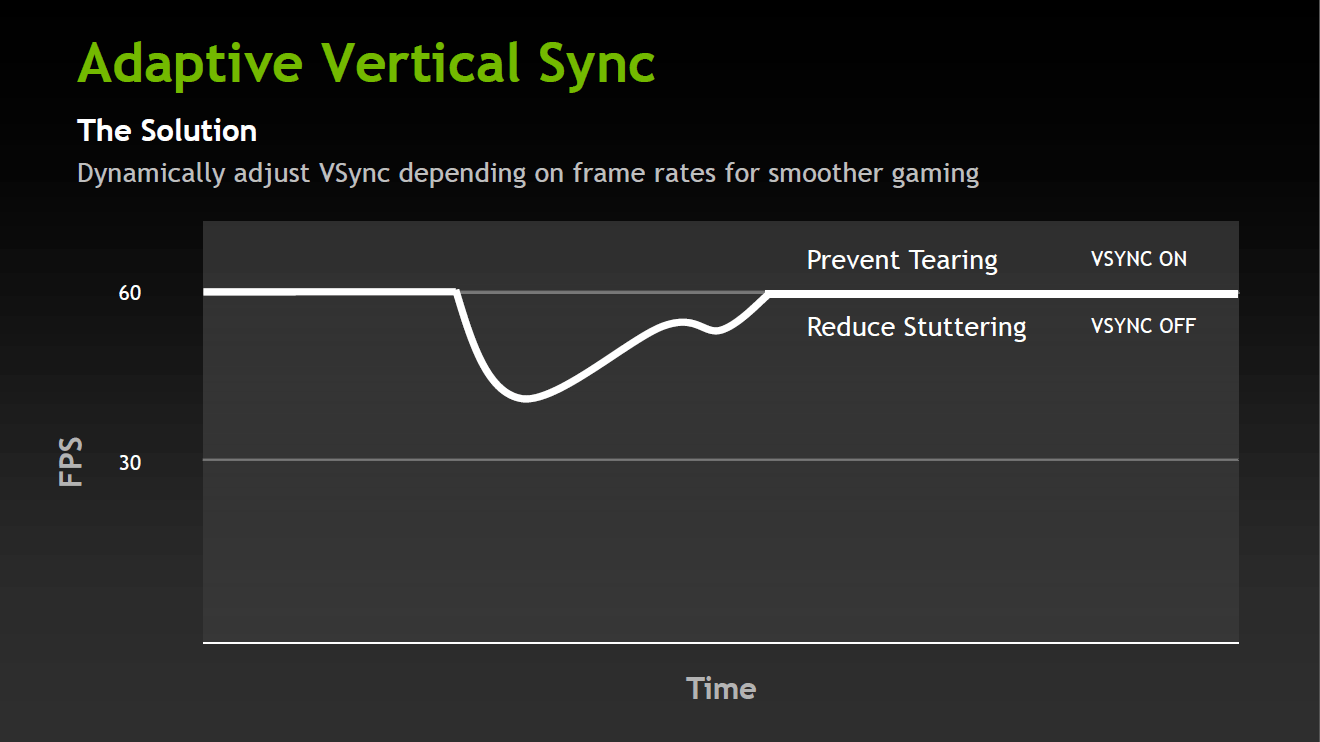
Adaptive VSync allows the game to perform at its real framerates below the 60fps mark, but then caps anything above at 60fps. This provides the best of both worlds, the smoothest possible performance, and the best perceived experience. High performing sections will be capped at 60fps, but then area that fall below will run at 45, 50 or 55fps, rather than all being cut to 30fps.
Taken together, GPU Boost and Adaptive VSync allows the GTX 670 to work as hard as it can to hit 60fps (by boosting clocks in stressful areas), and then capping that performance at 60fps (and lowering clocks back down) in easy sections.
FXAA & TXAA
The world of removing aliasing has certainly gotten rougher over the last few years. No longer do we just have "simple" methods (and "simple" being a relative term) such super-samling or multi-sampling which work at the pixel-level.
AMD recently added its own shader-based method, called MLAA (MorphoLogical AA). MLAA moves the AA calculations to the post-processing phase of the image pipeline (rather than the initial render). Beyond possible performance improvements, implementing AA as a post-process filter meant that virtually any "modern" title could benefit from anti-aliasing, even if it wasn't offered in the original code.
NVIDIA has countered with two newer AA methods of its own - FXAA and TXAA. FXAA (Fast Approximate AA), and is a single pass pixel shader that also runs as a post-processing effect. As with AMD's MLAA, NVIDIA now has an option in their control panel to force FXAA for any game. The expectation is that you can get 4xAA image quality with no performance hit. This would certainly be appealing to Surround users who need to squeeze out every frame per second.

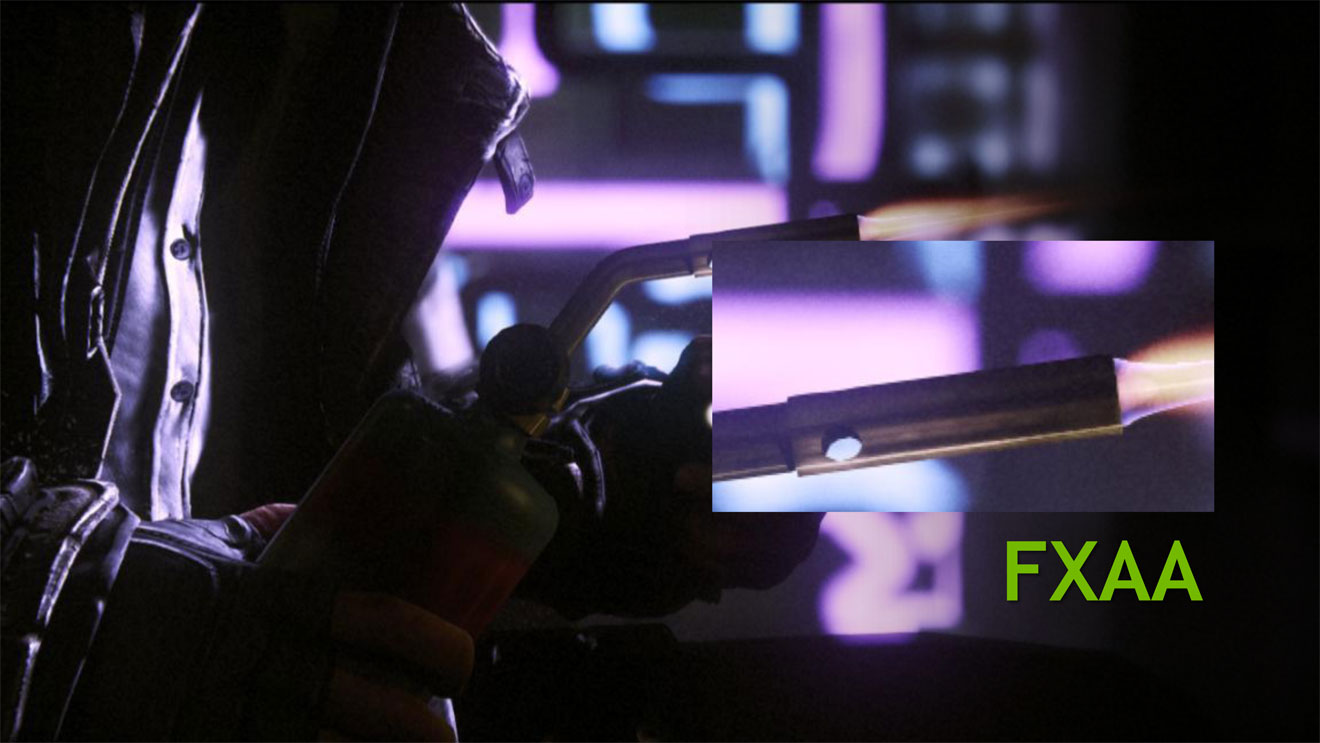
TXAA is the second custom offering from NVIDIA. it is a combination of hardware multi-sampling and custom shader AA code. The expectation is that you can get 8xAA image quality on object edges, but only see a 2xAA-level performance hit (which can often be minimal). For a 4xAA-level performance hit you can get "better than 8xAA" image quality.
The downside is that TXAA has to be implemented specifically in a title. It is being supported by developers such Crytek and Unreal, for their respective engines. This will hopefully make adoption widespread. It is also being adopted for specific titles such as Mechwarrior Online, Eve Online and Borderlands 2. With BL2 launching very soon, I will look to putting together an overview of all the different AA options available.

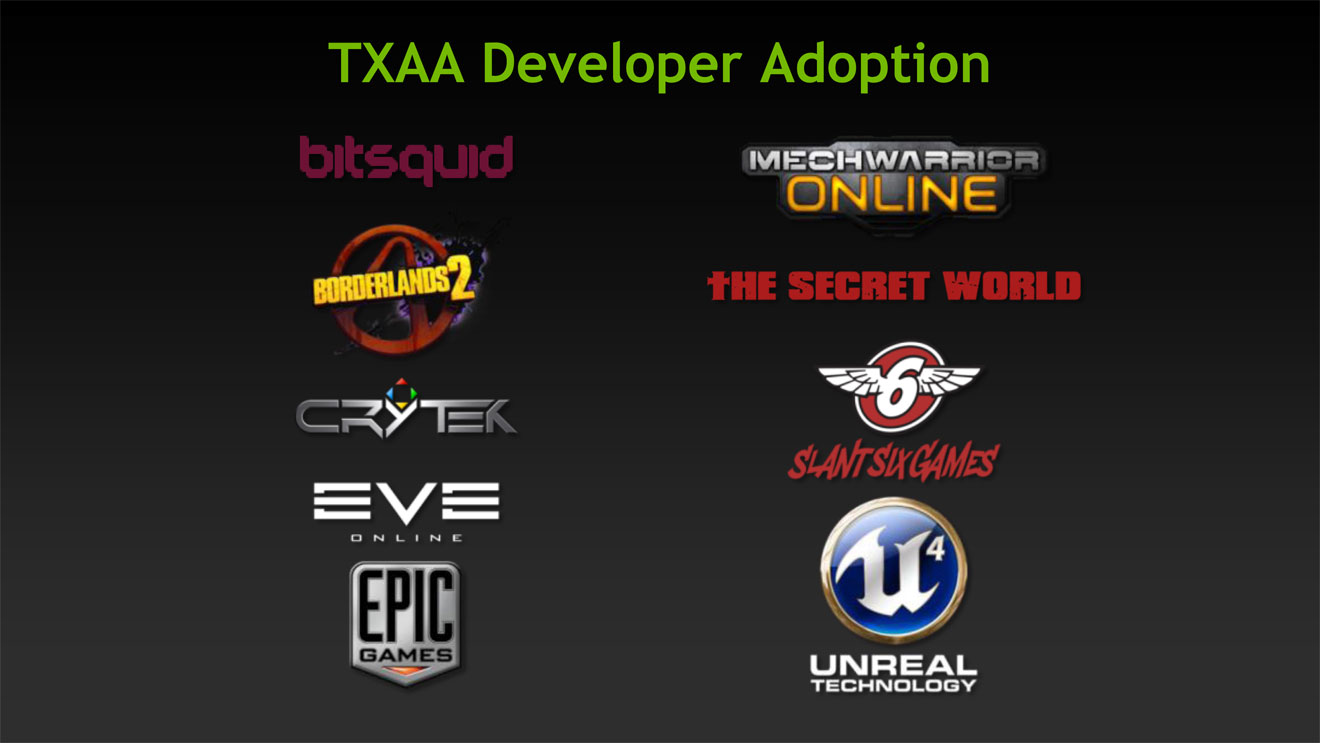
NVIDIA GeForce GTX 670 Review - Benchmarking
System Specs
- Windows 7
- ASUS P8Z68-V Pro/Gen3
- Intel i7 2600k at 4x3.4GHz
- 16GB G.Skill DDR3 1.25v low-voltage RAM
- 2x Samsung 320GB T-Series HDD (one for the OS and games; one for swap file and FRAPS)
- LG Super Multi Blu (HD-DVD/Blu-Ray Player)
- Onboard audio
- Corsair HX1000
- My Open PC Dragon Case
- Logitch K340 Keyboard & Performance MX Mouse
- Ergotech Heavy Duty Triple Desk Stand - WSGF Edition
- 3x Dell U2211H IPS 16:9 1920x1080 Displays
Hardware Tested
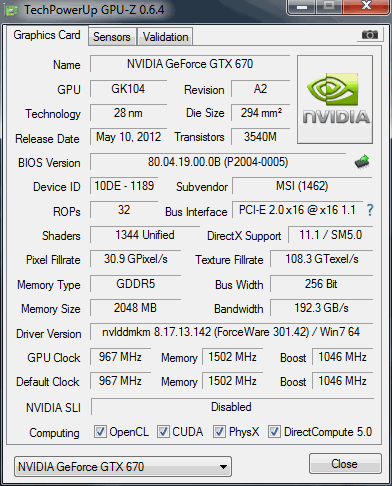
The NVIDIA card tested was the MSI GeForce GTX 670 model N670GTX-PM2D2GD5/OC. It was tested with the GeForce 301.42 drivers. The AMD Radeon HD 7970 and HD 7950 reference boards were tested with the release drivers for the Radeon HD 7970 GHz Edition.
Resolutions Tested
I tested both 1600x900 and 1920x1080 in widescreen, as well as 4800x900 and 5760x1080 in 3x1-L Eyefinity.
Games Tested
I have overhauled my suite of games. I replaced some older titles with their sequels, and I've simply dropped some titles either due to age or the time needed to benchmark. Additionally, I've dropped the DX9 and DX10 tests from the Heaven demo.
- Aliens vs. Predators
- DiRT 3
- H.A.W.X. 2
- Heaven v2.5 DX11
- Mafia II
- Metro 2033
- Total War: Shogun 2
As always, all games are tested at max settings (unless otherwise noted), with 4xAA and 16xAF enabled.
Future Testing
Hopefully we'll be getting our hands on some additional NVIDIA cards in the very near future.
NVIDIA GeForce GTX 670 Review - Aliens vs. Predator
Though it's closing in on two years old, the AvP stand-alone benchmark tool is still a good test of DX11 hardware. It isn't very demanding from a CPU perspective, so it gives a good test of the GPU itself.
The AvP demo also makes good usage of DX11 effects such as Advanced Shadows and Geometry Tessellation, particularly on the alien creature and the alien "pods". There are also some unique lighting effects created with a mobile lighting sources in a floor lamp that is battered around by the alien creatures as they clamor down a tight hallway.
In widescreen, the GTX 670 bests the Radeon HD 7950 by a few frames. Conversely in multi-monitor the Radeon HD 7950 bests the NVIDIA GTX 670 by a few frames.
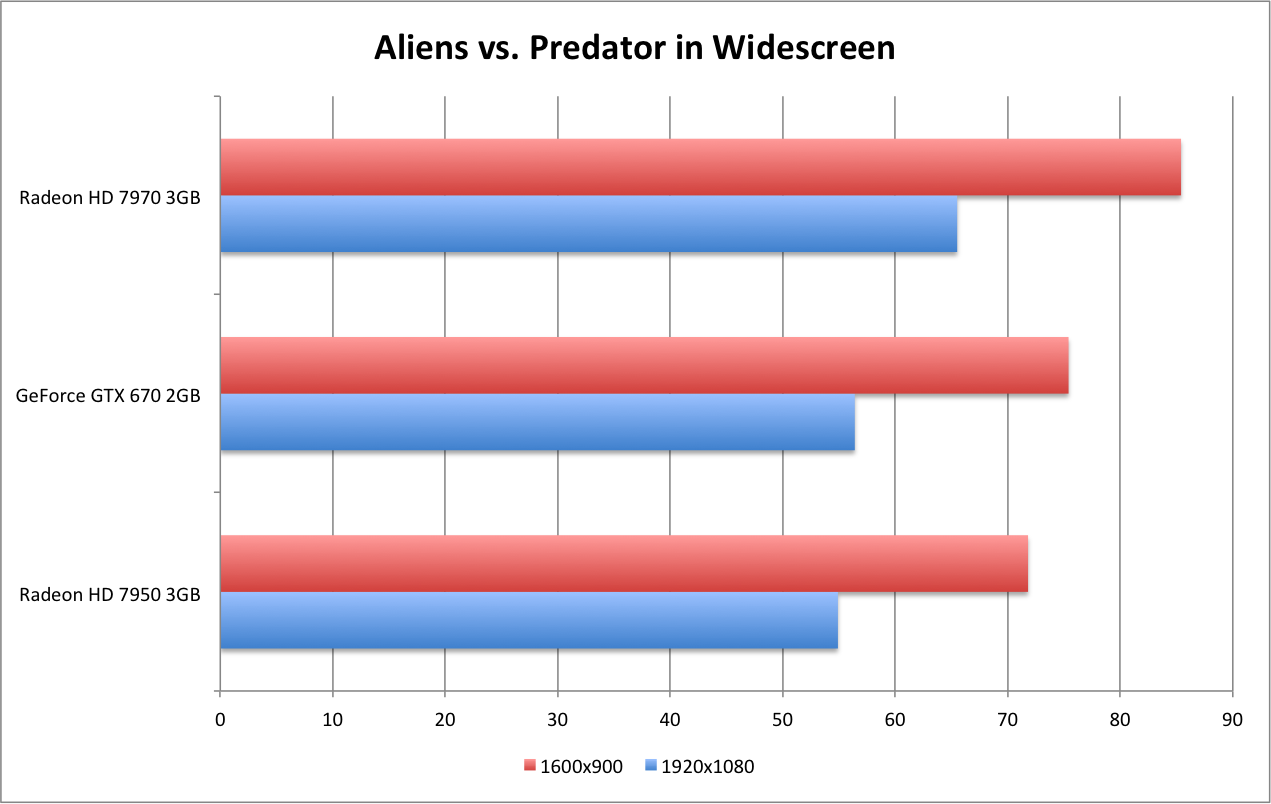

NVIDIA GeForce GTX 670 Review - DiRT 3
Dirt 3 has replaced our previous benchmark of Dirt 2. The Dirt 2 benchmark was the "urban" London circuit, which had several nice examples of water tessellation by way of the car driving through large puddles on the course. The Dirt 3 benchmark we use is the Aspen track, which is a long winding snow course.
Rather than water and cloth effects in Drt 2, the Dirt 3 course showcases snow covered trees that flank a snow-covered course. Tessellation effects are showcased by the tire tracks gouged into the snow. Additionally, there are continuous snow particles kicked up from the cars, and a better chance to see cars flipping and skidding. Overall, a nice and "pretty" update to our Dirt 2 benchmark.
The GTX670 bests even the Radeon HD 7970 in Dirt3, in both widescreen and multi-monitor. In single screen it bests the top-end AMD card by almost 20fps. in 1600x900 it almost hits 120fps, which should appeal to owners of 120Hz panels. With a bit of tweaking the GTX 670 should be able to hit a constant 120fps. The GTX 670 beats the Radeon HD in multi-monitor as well, with a margin of about 5fps. It approaches 60fps at 1600x900 on Ultra settings. A few tweaks should give a constant 60fps.
This is a title where the Adaptive VSync and GPU Boost will help create a great experience, particularly on a single 120Hz monitor.

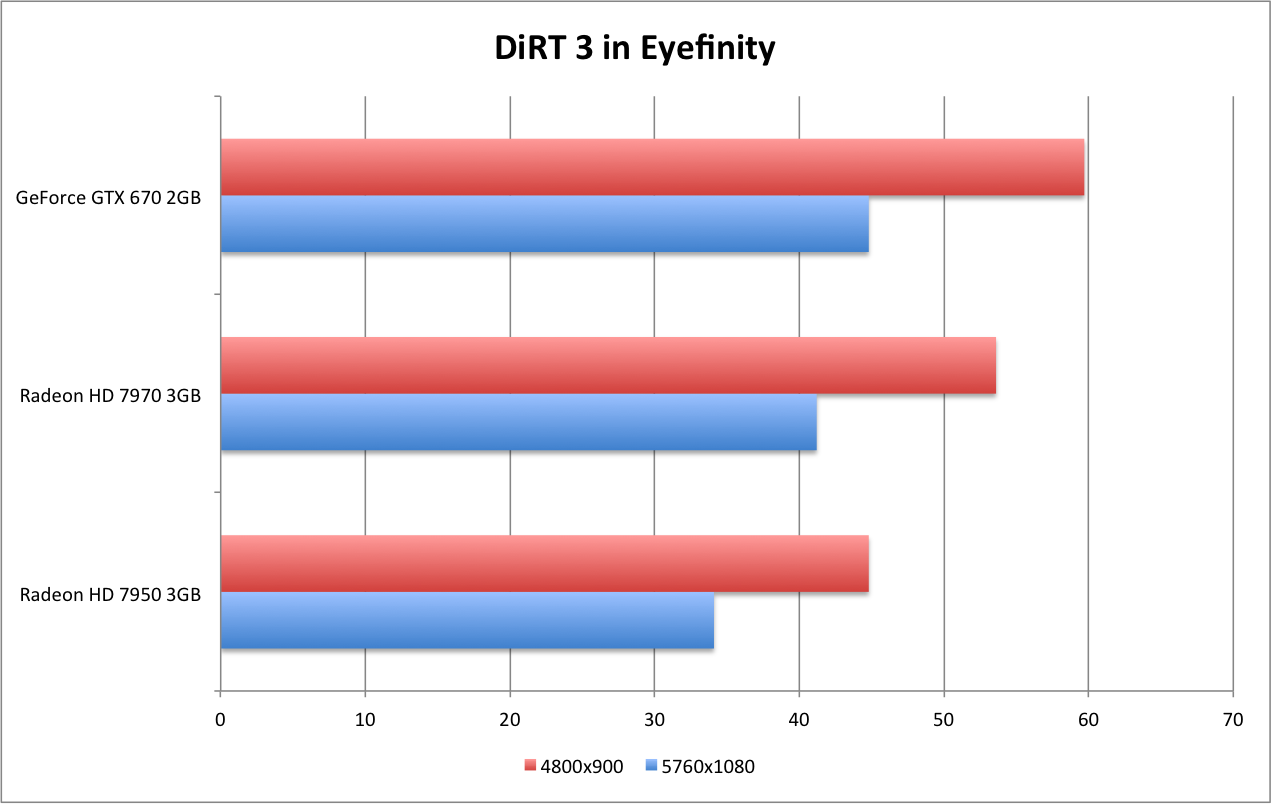
NVIDIA GeForce GTX 670 Review - H.A.W.X. 2
The sequel to the original HAWX updates the original by moving from DX10 to DX11, and utilizing tessellation on the mountainous landscape. The original HAWX demo provided a simple camera fly-through of an area populated by detailed cities and waterways. The "action" consisted mostly of ground explosions and some aircraft engagement.
The HAWX 2 demo removes the cities and water, and focuses on very detailed snow-covered mountain range with a large fleet of aircraft firing missiles. The viewpoint of the camera alternates between a third-person view over the top of a jet, as well as a first-person view inside the same craft.
The GTX 670 handily beats both Radeon cards, in both single and multi-monitor. For single screen, the GTX 670 tops the Radeon HD 7950 by about 30fps, and wins multi-monitor by about 10fps. While these wins are impressive, the reality is that all of the cards push past 120fps in single screen and 60fps in multi. Again, not to take away from the NVIDIA win, but it's simply overkill. One of the more mainstream cards from NVIDIA would still provide a great experience in HAWX 2.
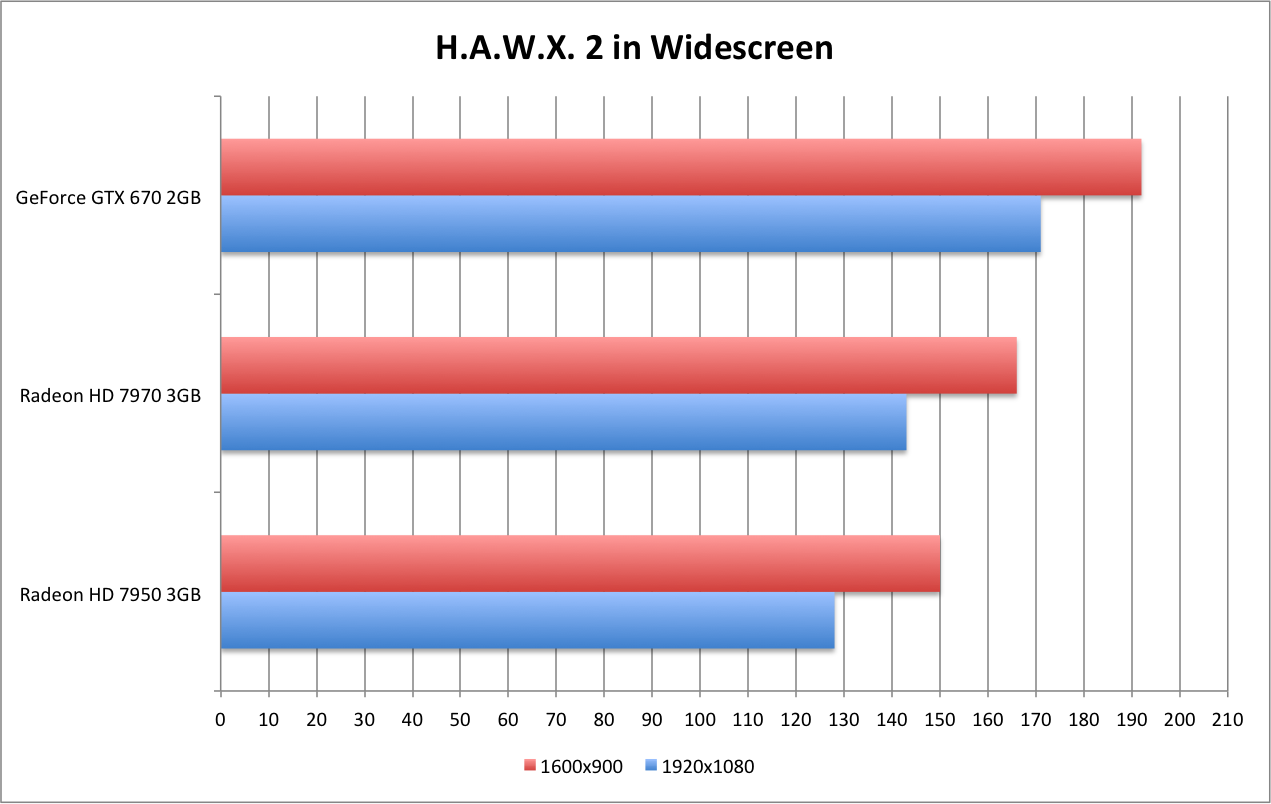

NVIDIA GeForce GTX 670 Review - Heaven v2.5 DX11
Update to the Heaven v2 demo, that has been an long-standing benchmark for many people. Though it's largely the same as the v2 demo, it does add a couple of new set pieces - particularly a new airship. This title is more demanding than the previous iteration, and adds a new tessellation options.
The Heaven demo continues to offer options for testing in DX9, DX10 and DX11 code paths. We have narrowed our testing to DX11, and are no longer testing the DX9 and DX10 code paths. The DX9 and DX10 were more CPU dependent and less of a test of the strength or weakness of the GPU. The DX11 truly stresses a GPU.
The GTX 670 bests the Radeon HD 7970 by 10fps at 1600x900, and 5fps at 1920x1080. In multi-monitor the GTX 670 slots in between the Radeon HD 7950 and the HD 7970.
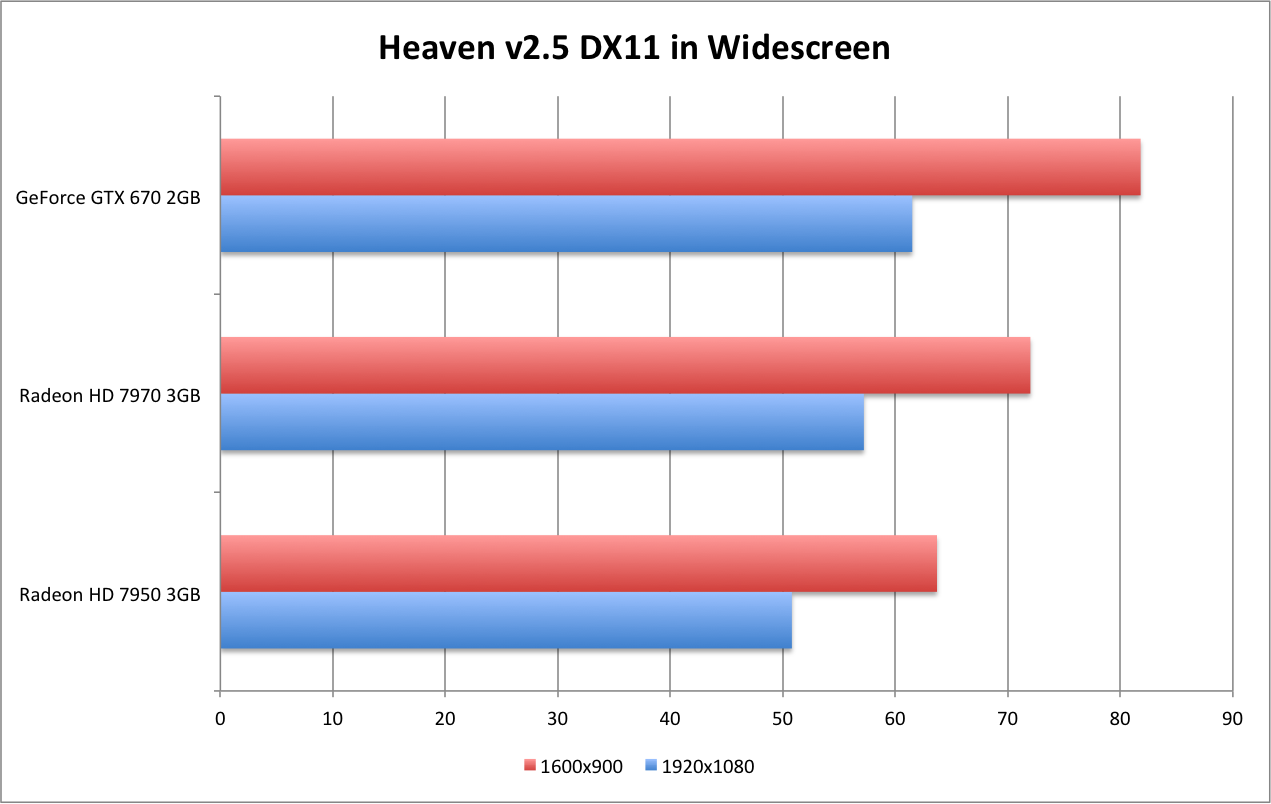
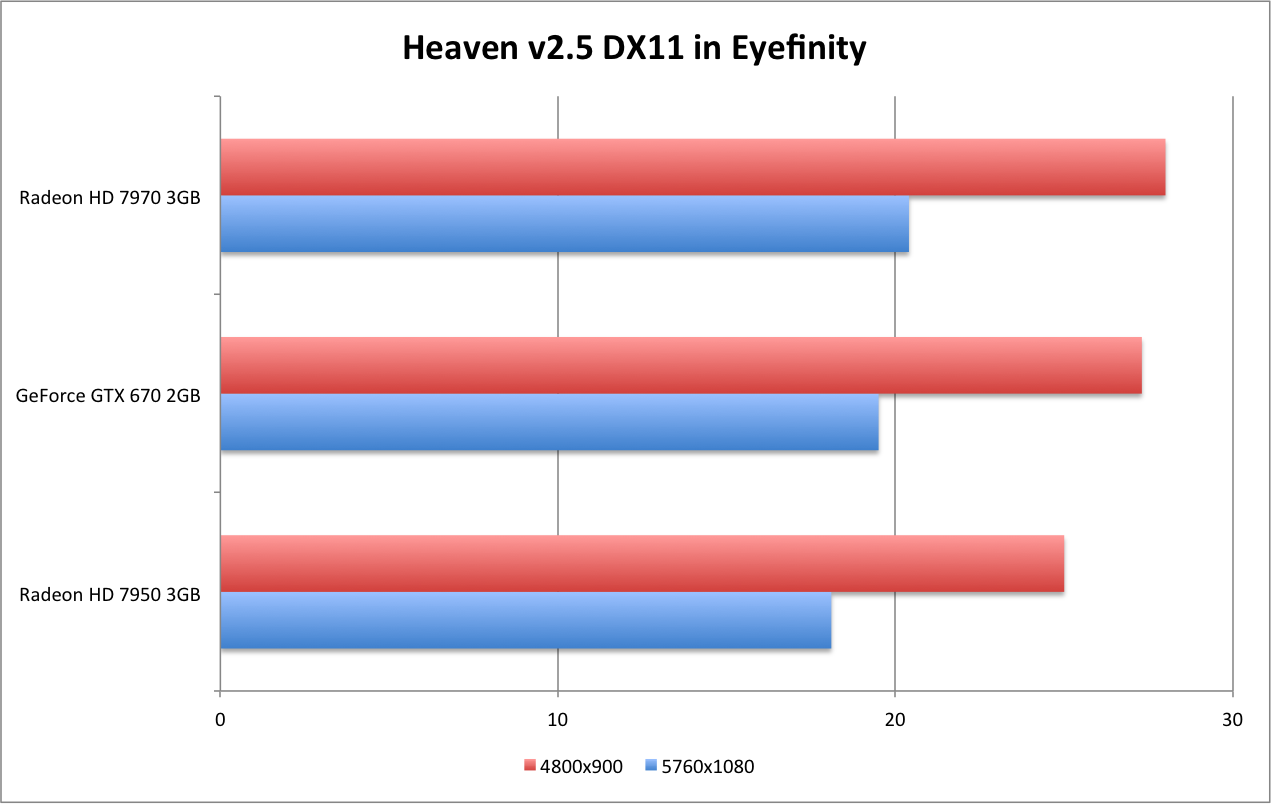
NVIDIA GeForce GTX 670 Review - Mafia II
Demanding benchmark that is included with the Mafia II open-world crime title. The title begins with an exterior gunfight, highlighting cars losing parts and being destroyed. The demo then moves inside a warehouse which highlights a gun battle, with destructible environments (brick columns) and excellent flame effects.
One thing to note is that the demo performs much better on a second run-through. The first run shows noticeable hiccups during the loading of different scenes. Subsequent runs run much smoother, though the overall average isn't seriously effected. The title does support PhysX, though we've tested with it turned off, to ensure a consistent comparison.
The GTX 670 really blows away the AMD products in the Mafia II demo. I reran the test several times, as I couldn't believe the difference in performance. In the end the settings were the same and the numbers were accurate. The title is an NVIDIA "The Way It's Meant to Be Played" title and is obviously optimized for the NVIDIA hardware.

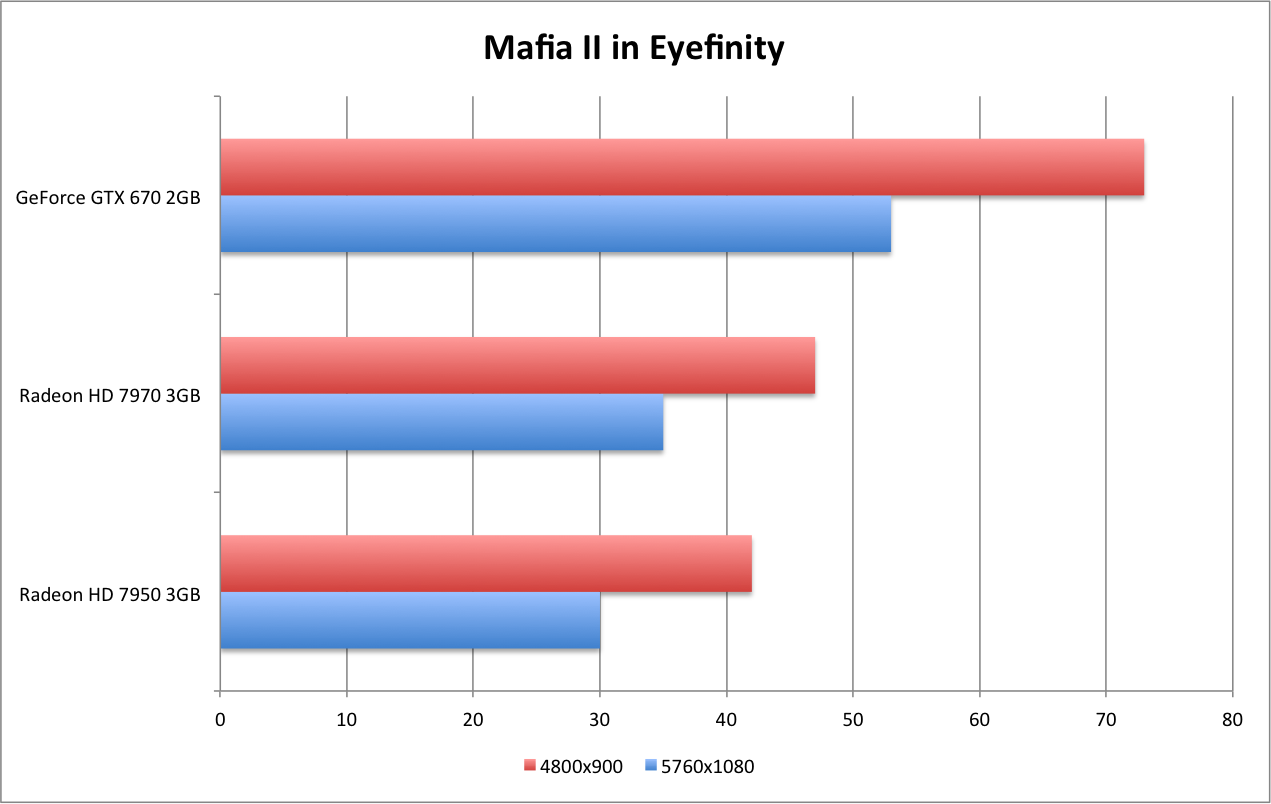
NVIDIA GeForce GTX 670 Review - Metro 2033
Demanding benchmark that is included in the popular FPS, Metro 2033. The demo is a camera fly through in a subway tunnel. There are large amounts of gunfire, cloth and lighting effects. The demo has a number of noticeable slowdowns from heavy flame, fog and motion blur effects. We run the game on the DX11 code path.
The GTX 670 slots directly between the two Radeon cards, in both widescreen and multi-screen. It bests the HD 7950 by a few frames, and is in turn beaten by the 7970 by a few frames.
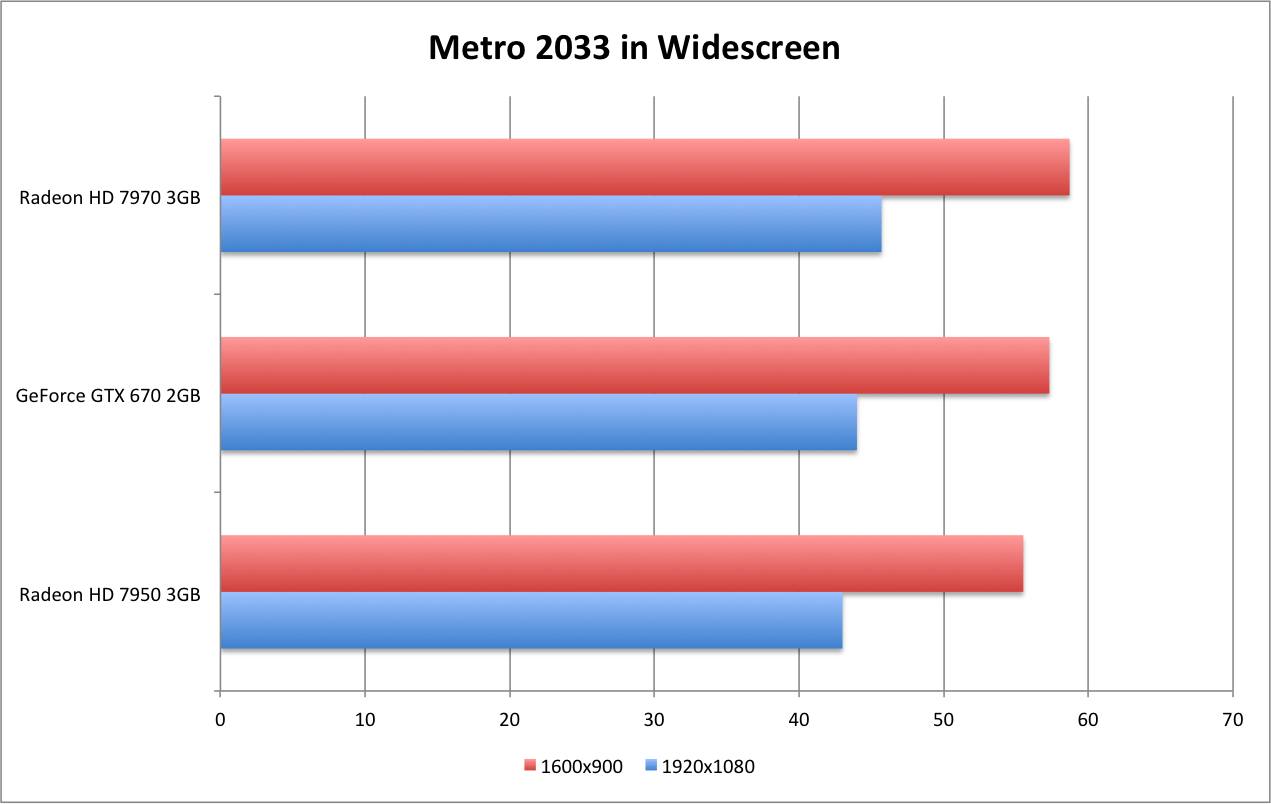
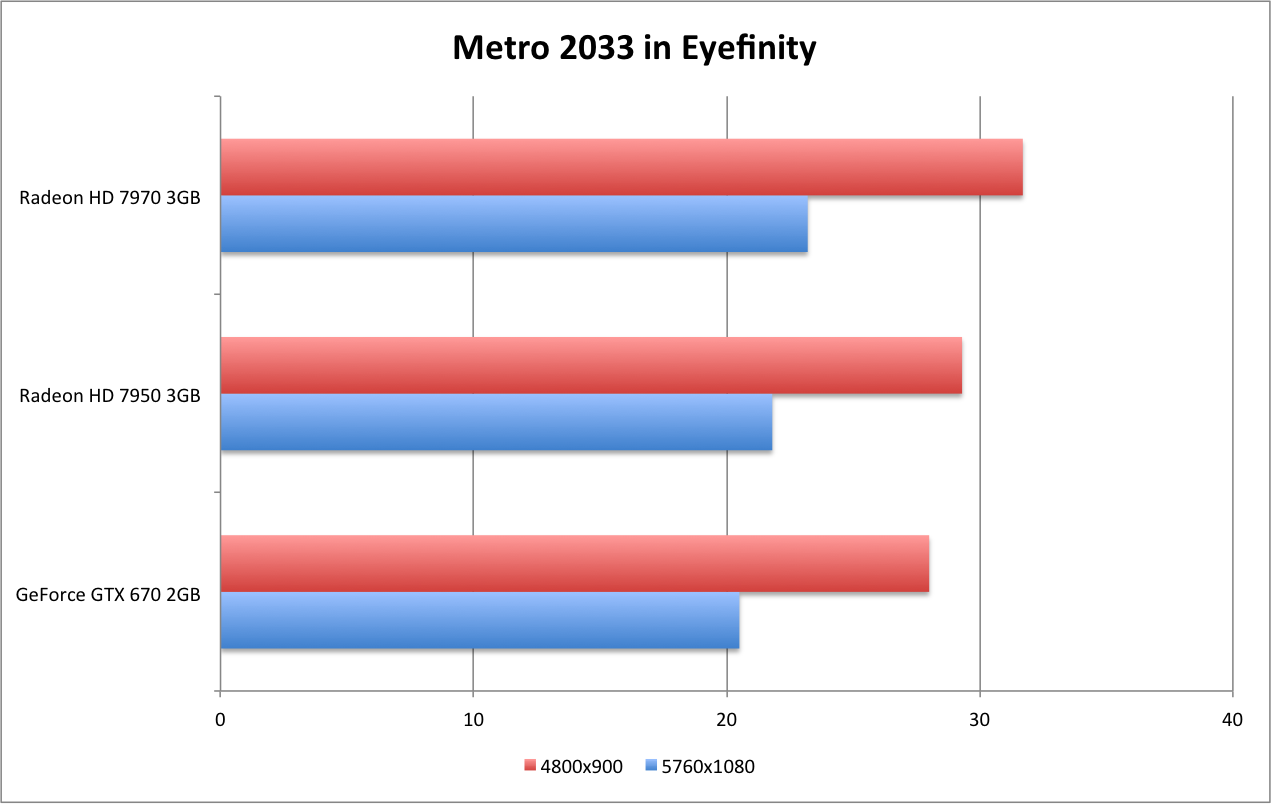
NVIDIA GeForce GTX 670 Review - Total War: Shogun 2
This benchmark is included with Total War: Shogun 2. This is the one instance we are not running at full "max" settings with 4xAA/16xAF. The benchmark simply will not run at these settings in Eyefinity on any 1GB card. To enable a consistent benchmark across all cards I've used these settings: "Very High" preset, 2xAA, and all the DX11 options turned on.
The title showcases a number of scenes - both broad views of large scale battles (with large numbers of units), and highlighting the detail in marching columns of soldiers.
This is the one title where the AMD cards are clear winners. The Radeon HD 7950 beats the GTX 670 by more than 10fps in widescreen, and almost 10fps in multi-monitor. Based on our experience with running this benchmark on a range of AMD video cards, we've found that RAM is a major limiting factor in performance and even in allowing the benchmark to run. I believe the extra RAM on the Radeon cards is helping performance here. Additionally Shogun 2 is an AMD "Gaming Evolved" title and has been optimized for their hardware.
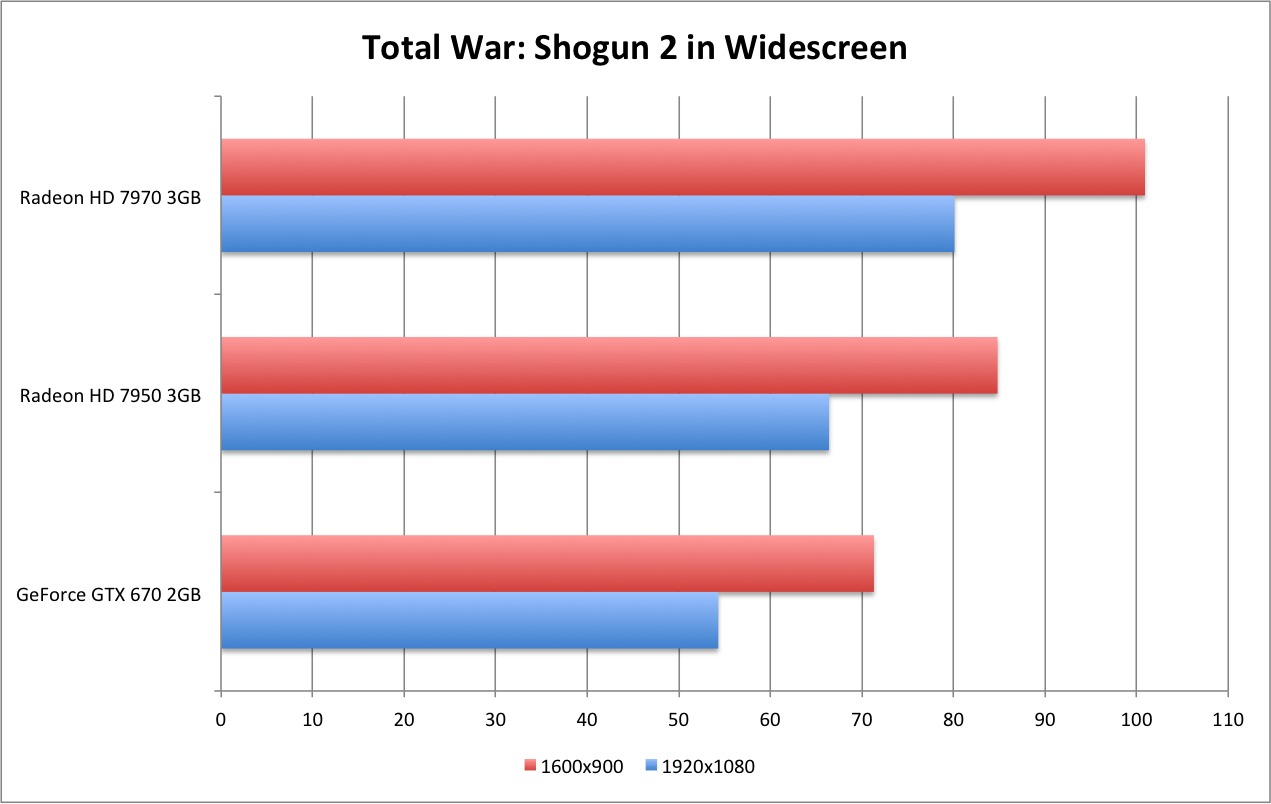
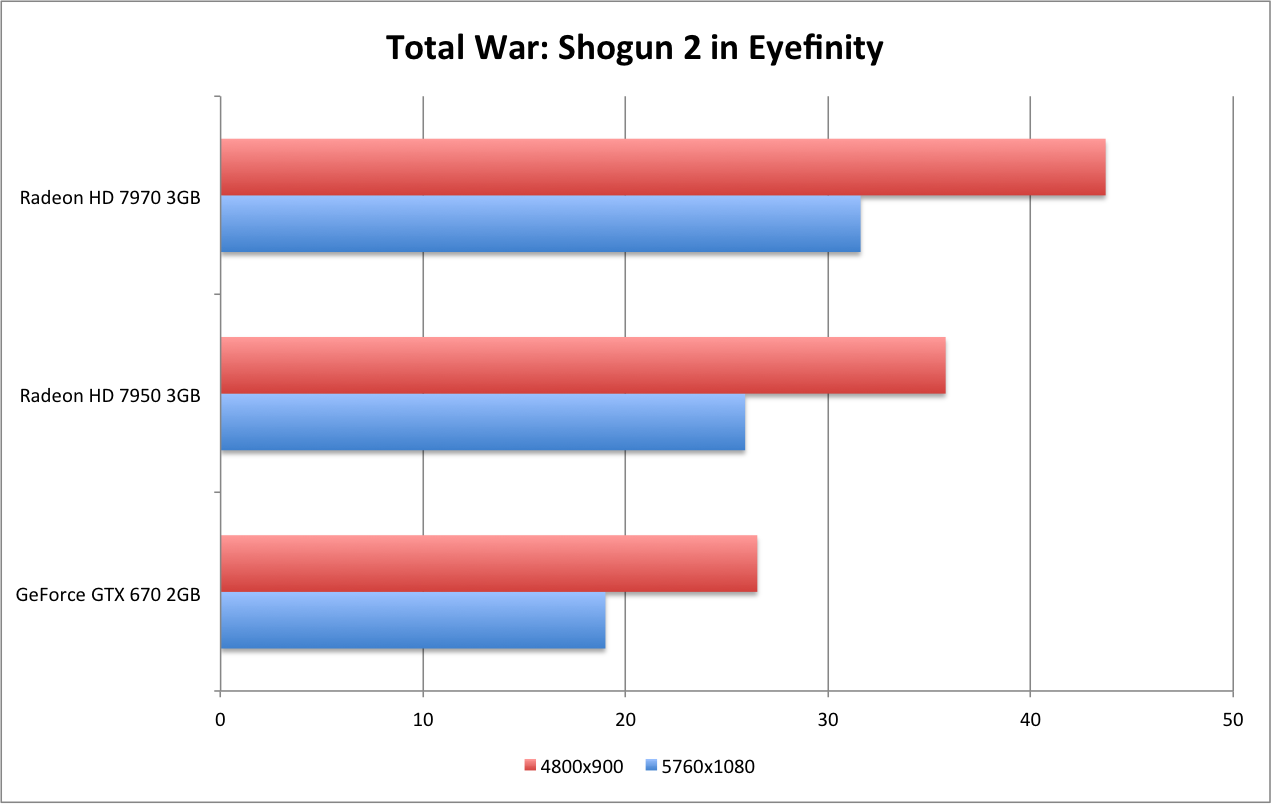
NVIDIA GeForce GTX 670 Review - Heat, Noise & Final Thoughts
Noise & Heat Profile
In the past I haven't taken much time to review the noise or heat profiles of the AMD cards we've tested. You would expect that bigger cards would be louder and hotter; but without anything from NVIDIA for comparison. Now that I have card from both camps the differences in noise and heat profiles are important to investigate and discuss.
First thing you'll notice is that the GTX 670 is shorter than the AMD offerings, and much lighter. The circuit board itself is only seven inches long. The power connectors site about 2/3 down the length of the card, rather than at the end. The last 2.5 inches of the card are reserved entirely for the fan. Like the HD 7950, the GTX 670 uses two 6-pin power connectors; but it is estimated to draw 30W more power in average usage.
The back of the GTX 670 has a full-size DisplayPort connection, along with an HDMI and two DL-DVI connectors. The exhaust port is only half of one side of the GTX 670, while the exhaust ports on the AMD offerings take up one whole side. I don't have an anemometer to measure the exact air flow, but the AMD cards blow more air across a larger area. Additionally, that air is hotter. The Radeon HD 7950 blows air ranging from 120 - 130 degrees F, while the HD 7970 blows even hotter nearing 140 degrees F. The GTX blows less air, and it is cooler - not breaking 125 degrees.
The GTX ends up being slightly cooler and quieter than the Radeon HD 7950, and much cooler and quieter than Radeon HD 7970.
| Card | Volume (db) | Exhaust Temp (F) | Area Temp (F) | Length (in) | Weight |
| Ambient | 38.5 | --- | 76.5 | --- | --- |
| GeForce GTX 670 | 43.0 | 120 - 123 | 80.0 | 9.5 | 1lb. 5oz. |
| AMD Radeon HD 7970 | 49.5 | 130 - 138 | 84.0 | 11.0 | 2lb. 4oz. |
| AMD Radeon HD 7950 | 44.0 | 120 - 130 | 81.0 | 11.0 | 2lb. 3oz. |
| Noise and temperature levels taken after two passes (approx 10 minutes) of running the Heaven 2.5 Demo. The "area temp" is taken from my sitting position at my desk. | |||||
Final Thoughts
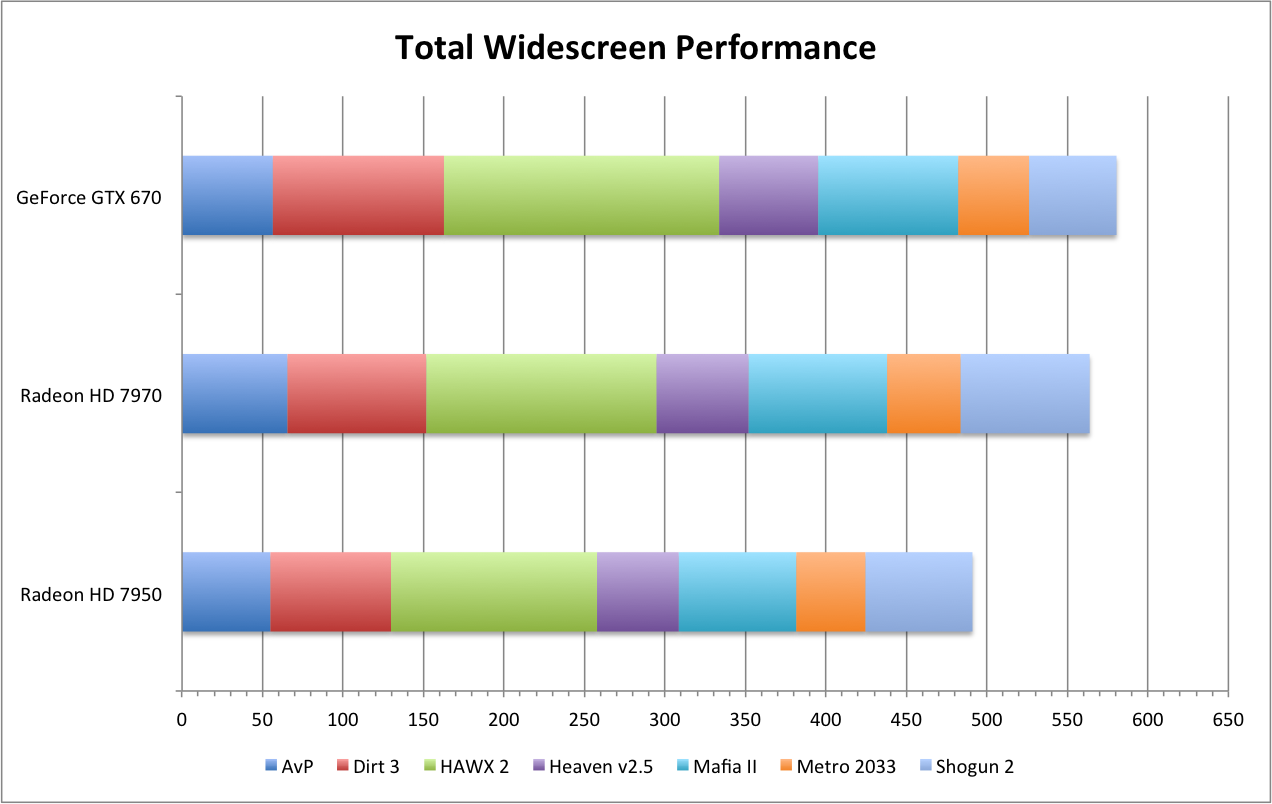
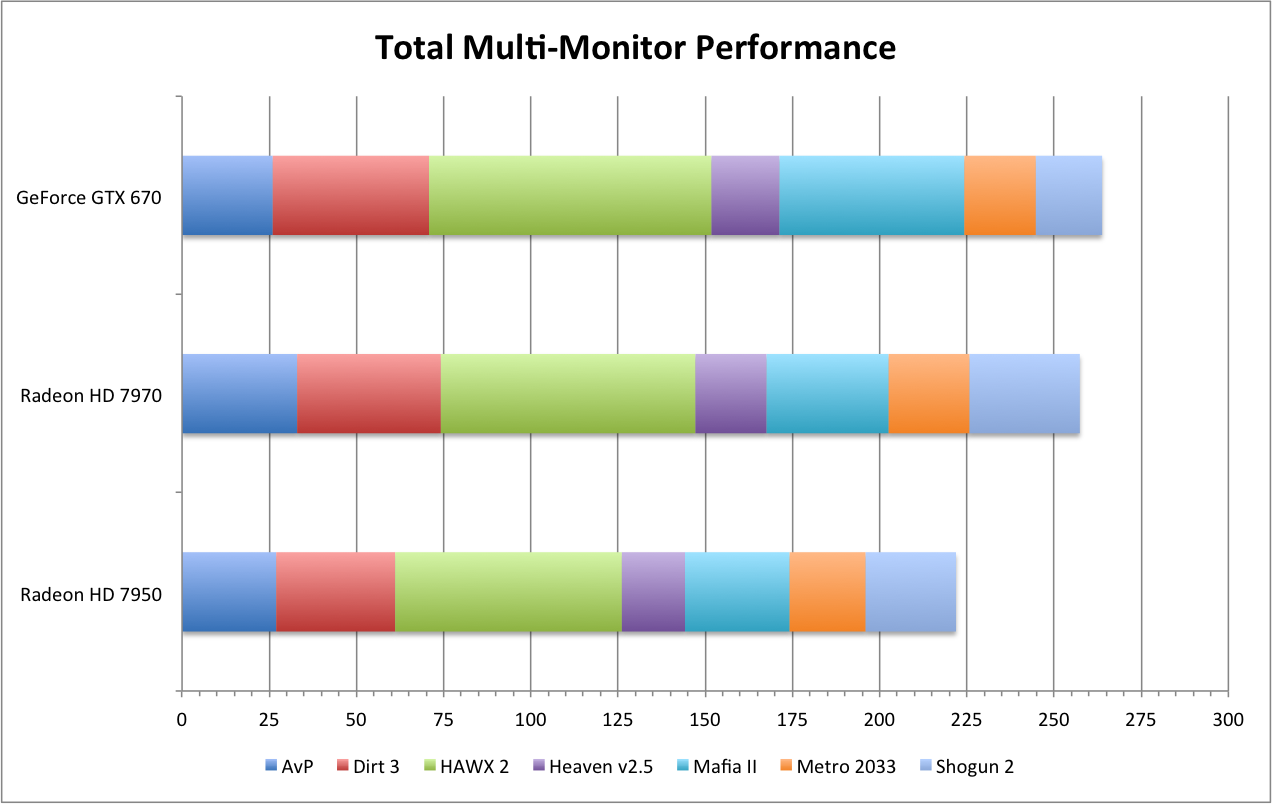
Bottom line - it's my new favorite card. Now, if I can just get my hands on a GTX 680 or GTX 690..
The GTX 670 is a great card - it's fast, quiet and cool. Even OC'd like the MSI N670GTX-PM2D2GD5/OC, the GTX 670 is simply stellar. It outperforms the reference versions of both the AMD Radeon HD 7970 and Radeon HD 7950. It's almost 20% faster than the Radeon HD 7950, and a few percent faster than the Radeon HD 7970.
The results are skewed a bit due to a couple of the "big wins". Take out HAWX 2 (for which these cards are all overkill), and the GTX 670 is only 13% faster than the HD 7950 in widescreen, and a few percent slower than the HD 7970. Take out Mafia II, and the GTX 670 is 10% faster than the HD 7950, and only a few percent lower than the HD 7970.
So, from an "sum total" viewpoint, the select of games you look at can have a bit of an impact on the results. Taking out the Shogun 2 results would make the GeForece GTX 670 look even better. Bottom line, in almost every instance the MSI OC'd GTX 670 is much faster than the Radeon HD 7950 and a hair faster than the HD 7970. It does this with being cooler and quieter than both cards, and quite a bit it's cheaper than the Radeon HD 7970.
The NVIDIA GeForce GTX 670 offers best in class performance for both widescreen and multi-monitor. Bottom line - it's my new favorite card. Now, if I can just get my hands on a GTX 680 or GTX 690...